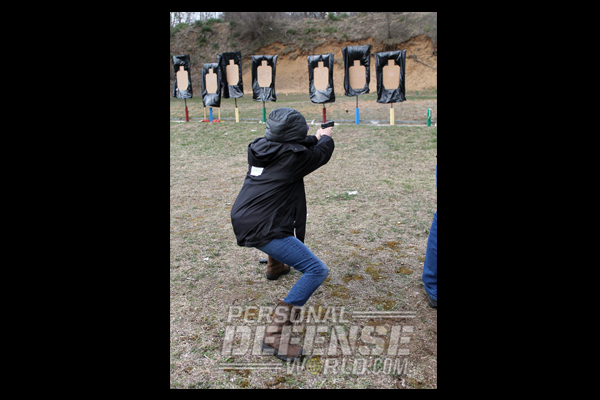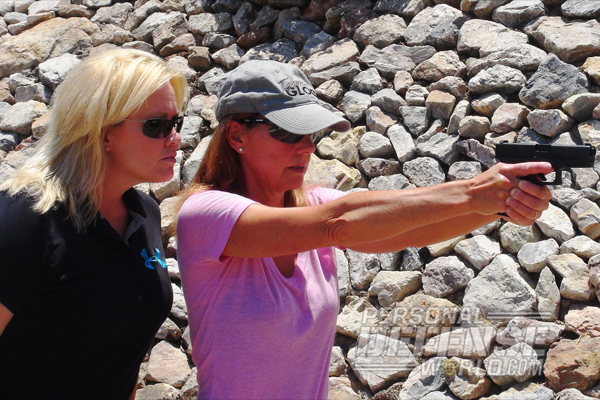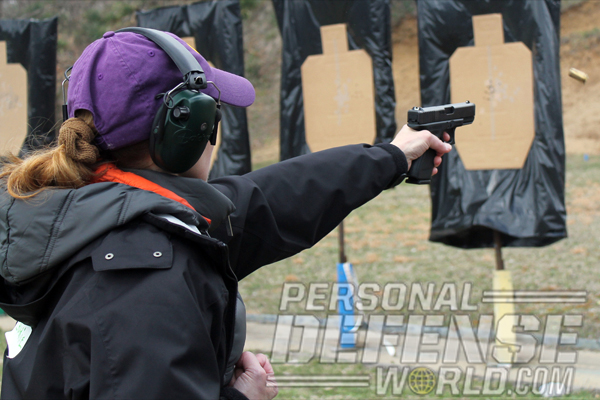As a law enforcement firearms instructor since 1972 and as a trainer of armed private citizens since 1981, I’ve had the time to observe shooters of both genders operate every common defensive firearm now in use, including the GLOCK. One thing I’ve noted—and it should be obvious to even the most inattentive observer—is the huge popularity of GLOCK autopistols. Another is that the GLOCK seems to be particularly popular with female shooters.
It’s no secret that the world of the gun is male-dominated.
“Why GLOCKs and female shooters so easily get along!”
“Why GLOCKs and female shooters so easily get along!”
Firearms are symbolic of two warrior professions, the armed forces and law enforcement, both of which have historically been very much male-dominated. With that background, it’s no surprise that most handguns have traditionally been designed “by males, for males.” Digging further, you discover that most were geared toward average- or larger-than-average-sized males, at that. Any physical skills instructor who trains both genders will probably tell you that the female of our species generally has inherently better fine-motor skills but less upper body strength than a male of the same height and weight. Moreover, women tend to be shorter and lighter than men.
Advertisement — Continue Reading Below
The difference corresponds to hand size as well. Place the hand of a petite female palm-to-palm with that of an average adult male, and the woman’s fingers will generally be one digit shorter than the man’s. Thus, hand-to-gun fit is critically important. To someone using a semi-automatic pistol who lacks great upper body strength, a slide that does not take great strength to operate is an important feature. There is also the matter of recoil. Let’s look at how all of these come together in the GLOCK autopistol.
HAND SIZE & FIT:
In 1911, the U.S. military adopted the Colt .45 AUTO pistol, designed by the great John Browning. After World War I, debriefing American combatants on how their weaponry had worked in the Great War, Army Ordnance received many complaints about the trigger’s reach being too long. At that time, nearly a century ago, the average military man was shorter than his counterpart of today—rather close to that of the average modern American woman, actually—with proportionally sized fingers. In the 1920s, the 1911 became the 1911A1, distinguished, among other things, by a shortened trigger and a frame niched out behind the trigger to further shorten the “trigger reach.” The features were established parts of military handgun design history during the seminal period in which Gaston Glock and his engineers designed the modern pistol that bears his name.
Advertisement — Continue Reading Below
The result is that the GLOCK’s trigger reach seems to work well even for petite females. This is even more true today with the recent introduction of GLOCK’s Gen4s, which have the shortest trigger reach in the history of the brand. Moreover, the GLOCK’s polymer frame lends itself to customizing that can shorten the reach still further. The Anchorage, Alaska, Police Department long ago adopted the GLOCK 21 in .45 AUTO as its standard service sidearm. However, recognizing that not only female officers, but also shorter-statured males with proportionately small hands might have particularly short fingers, the APD put two options in place. One was the GLOCK 22 pistol, the slimmer-gripped, .40-caliber service pistol that has long since been standard for Alaska State Troopers. The other option was to have either the G21 or the G22 sent to Robar Industries, where the department paid for the grip to be reshaped to reduce the trigger reach still further. The changes have been starkly effective. Across the genders, this all-GLOCK police department has logged an approximately 90-percent hit ratio in gunfights on the street.
EASE OF USE:
Being able to operate the slide of a semi-automatic pistol is as critical to life-saving performance as being able to pump a slide-action shotgun. At the time the GLOCK hit the scene, the hot service pistol was the double-action, hammer-fired semi-automatic. To actuate the slide, the user had to overcome not only the resistance of the recoil spring parallel to the barrel, but also the mainspring in the frame holding the hammer down against the back of the slide. With a traditional double-action, whose hammer is down only for the first shot, this could be bypassed by cocking the hammer to relieve mainspring pressure, but that took extra time and movement. With the then-popular double-action-only models, the hammer could not be cocked at all, and the user had to struggle against, literally, two opposing forces. Enter the GLOCK, whose striker-fired mechanism was pre-tensioned. The slide was simply easier to operate for everyone. Easy for big, strong guys. Easy for wounded officers who might have an arm injury. And, most obviously, easy for the female personnel, who on average have less upper-body strength than their brothers.
With a lower bore axis than virtually all of the other double-action-only police pistols then on the market, the GLOCK’s muzzle simply didn’t rise as much, and came back on target faster than competitor guns firing the same ammunition from the same stance in the hands of the same shooter. The polymer frame, as high-speed photography showed, flexed very slightly on firing, which helped absorb recoil, too.
Advertisement — Continue Reading Below
DISPARATE IMPACT:
The early 1970s saw females break the glass ceiling in law enforcement, becoming full-fledged patrol officers instead of “police matrons” and “policewomen” assigned to lighter and less-hazardous duties. The old paradigm of issuing .38-caliber service revolvers to “policemen” but underpowered .32-caliber guns to “policewomen” who wore uniform skirts and “stewardess caps” became a thing of the past, with street cops of both genders wearing the same uniforms and the same equipment. This posed a problem, however.
The same uniform could be issued in different, appropriate sizes, with each officer properly fitted. The equipment—not so much. A service handgun designed for the average adult male now found itself in the hand of a user whose trigger finger might be a digit too short to gain adequate leverage to control the gun. Female officers who qualified in every other respect were sometimes seen to fail male-oriented courses with male-oriented techniques, largely because they were issued guns designed for average-sized or larger male hands. The result was a spate of lawsuits filed by female LE personnel who had been fired for failure to qualify with male-oriented guns. They were able to show that they could shoot perfectly well with guns that fit their hands. As an expert witness, I did my first such case in 1980, and over the years I’ve spoken in court for some 40 female LEOs who had lost their jobs over this issue. In the great majority of cases, the women prevailed, costing the departments that had fired them a great deal of taxpayer money. We saw it with revolvers, and we saw it with conventional, hammer-fired, double-action autopistols.
Consider this: In all these decades, I have never been presented with a case where a competent female officer was fired because she could not qualify with a GLOCK, but could qualify with another type of pistol.
Advertisement — Continue Reading Below
CLICK HERE for GLOCK’s Next Gen G41, G30s and G42 | Video
EVERYDAY CITIZENS:
This article has concentrated thus far on the GLOCK in law enforcement simply because that is an environment in which every gun-user’s skill is regularly measured to a certain recorded standard, and the user who cannot demonstrate baseline competence stands to lose his or her job. It is an issue that has been litigated, and it’s something that has been quantified in police department qualification records. Let’s look now at the world of the private citizen, where persons of either gender can pick their own firearm. I have been shooting in handgun competitions since the 1960s and have noted that people tend to purchase and use the guns they shoot best. I cannot help but notice that in action-shooting sports such as IDPA and IPSC/USPSA, GLOCKs are disproportionately used by both genders, and they’re especially prevalent among female shooters.
Advertisement — Continue Reading Below
Soft recoil for the given caliber, fast recovery from muzzle flip, a “reachable” trigger and an easily manipulated slide mechanism all play into the GLOCK’s “female-friendly” profile. So do other factors. One such factor is that the GLOCK is available in a wide variety of sizes per caliber. In 9×19 alone, the lady can choose the 6-inch-barreled GLOCK 17L, the 5.3-inch-barreled “Tactical/Practical” GLOCK 34, the standard-size GLOCK 17 with a 4.5-inch barrel, the compact GLOCK 19 with a 4-inch barrel and slightly truncated butt, or the subcompact GLOCK 26, which features a barrel barely over 3.5 inches and a stubby grip frame so easily concealed that it works for pocket or ankle carry. Female wardrobe constraints tend to be more challenging for concealed carry than menswear, making “size of the gun” options somewhat more important for armed women than for armed men.
From the world of handgun competition to law enforcement to the burgeoning number of women purchasing handguns for concealed carry or for home defense, the history of the GLOCK pistol is a history of a handgun that has proven itself to be “female-friendly.” Designed for no gender in particular, the GLOCK, by virtue of its outstanding handling characteristics, nevertheless meets the needs of lawfully armed woman in America today.
For more information on GLOCK Handguns, visit: http://us.glock.com/
Advertisement — Continue Reading Below

































